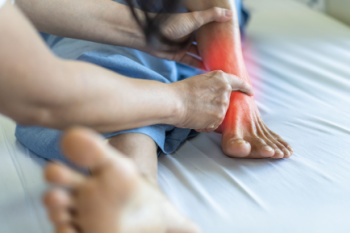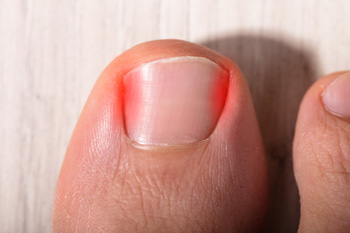Connect With Us
Items filtered by date: July 2024
What Causes Tarsal Tunnel Syndrome?

Tarsal tunnel syndrome, also known as tibial nerve dysfunction, is a condition where the tibial nerve is compressed or irritated as it passes through the tarsal tunnel, the narrow passageway on the inside of the ankle beneath the ankle bones. This compression can result from various causes, such as injury, swelling from ankle sprains, arthritis, or structural abnormalities like flat feet. Symptoms of tarsal tunnel syndrome include tingling, burning pain, or numbness of the inner ankle and sole of the foot. Some individuals may experience a shooting pain that radiates up the leg or into the toes. Symptoms tend to worsen with prolonged standing or walking. Proper diagnosis involves a thorough medical history, physical examination, and sometimes imaging tests like MRI scans to evaluate nerve compression. Relief options include rest, anti-inflammatory medications, orthotic devices, and in severe cases, surgical decompression to relieve pressure on the nerve. If you have developed ankle pain, it is suggested that you consult a podiatrist who can provide a proper diagnosis and offer treatment options that are right for you.
Tarsal tunnel syndrome can be very uncomfortable to live with. If you are experiencing tarsal tunnel syndrome, contact one of our podiatrists of Podiatry Health Center. Our doctors can provide the care you need to keep you pain-free and on your feet.
Tarsal Tunnel Syndrome
Tarsal tunnel syndrome, which can also be called tibial nerve dysfunction, is an uncommon condition of misfiring peripheral nerves in the foot. The tibial nerve is the peripheral nerve in the leg responsible for sensation and movement of the foot and calf muscles. In tarsal tunnel syndrome, the tibial nerve is damaged, causing problems with movement and feeling in the foot of the affected leg.
Common Cause of Tarsal Tunnel Syndrome
- Involves pressure or an injury, direct pressure on the tibial nerve for an extended period of time, sometimes caused by other body structures close by or near the knee.
- Diseases that damage nerves, including diabetes, may cause tarsal tunnel syndrome.
- At times, tarsal tunnel syndrome can appear without an obvious cause in some cases.
The Effects of Tarsal Tunnel Syndrome
- Different sensations, an afflicted person may experience pain, tingling, burning or other unusual sensations in the foot of the affected leg.
- The foot muscles, toes and ankle become weaker, and curling your toes or flexing your foot can become difficult.
- If condition worsens, infections and ulcers may develop on the foot that is experiencing the syndrome.
A physical exam of the leg can help identify the presence of tarsal tunnel syndrome. Medical tests, such as a nerve biopsy, are also used to diagnose the condition. Patients may receive physical therapy and prescriptive medication. In extreme cases, some may require surgery.
If you have any questions please feel free to contact our office located in Dothan, AL . We offer the newest diagnostic and treatment technologies for all your foot and ankle needs.
How to Manage an Ingrown Toenail

Ingrown toenails occur when the edge of the nail grows into the surrounding skin, leading to redness, swelling, and tenderness, often causing incredibly painful. Common causes include improper trimming, wearing tight footwear, or injury. Symptoms may worsen if left untreated, potentially leading to infection. Initial treatment involves soaking the affected foot in warm water and gently lifting the nail edge with a clean instrument to reduce pressure. Avoid cutting the nail yourself, as this can invite infection and make it worse. Wearing comfortable shoes and practicing proper nail care can help to prevent recurrence. For persistent pain, signs of infection like pus, or increased redness, it is important to consult a podiatrist. They can provide professional care, including minor surgical procedures to remove the ingrown portion of the nail and prevent future problems. If you have an ingrown toenail, It is suggested you schedule an appointment with a podiatrist for an expert evaluation and tailored treatment plan to alleviate ingrown toenails effectively.
Ingrown toenails may initially present themselves as a minor discomfort, but they may progress into an infection in the skin without proper treatment. For more information about ingrown toenails, contact one of our podiatrists of Podiatry Health Center. Our doctors can provide the care you need to keep you pain-free and on your feet.
Ingrown Toenails
Ingrown toenails are caused when the corner or side of a toenail grows into the soft flesh surrounding it. They often result in redness, swelling, pain, and in some cases, infection. This condition typically affects the big toe and may recur if it is not treated properly.
Causes
- Improper toenail trimming
- Genetics
- Improper shoe fitting
- Injury from pedicures or nail picking
- Abnormal gait
- Poor hygiene
You are more likely to develop an ingrown toenail if you are obese, have diabetes, arthritis, or have any fungal infection in your nails. Additionally, people who have foot or toe deformities are at a higher risk of developing an ingrown toenail.
Symptoms
Some symptoms of ingrown toenails are redness, swelling, and pain. In rare cases, there may be a yellowish drainage coming from the nail.
Treatment
Ignoring an ingrown toenail can have serious complications. Infections of the nail border can progress to a deeper soft-tissue infection, which can then turn into a bone infection. You should always speak with your podiatrist if you suspect you have an ingrown toenail, especially if you have diabetes or poor circulation.
If you have any questions, please feel free to contact our office located in Dothan, AL . We offer the newest diagnostic and treatment technologies for all your foot care needs.
Cause of Pain on Top of the Foot

Experiencing pain on the top of the foot is a common issue among runners and active individuals. One cause of this discomfort is extensor tendonitis, an inflammation of the extensor tendons responsible for lifting and straightening the toes. These tendons are vulnerable to injury because they lack protection from bones, muscles, or fatty tissue. Factors that place undue stress on the tendons include tight calf muscles, overtraining without adequate rest, and wearing improperly fitting shoes. Symptoms of extensor tendonitis include pain on the top of the foot during movement, swelling, and sometimes a visible bump along the tendon. Adjusting the way you lace your shoes can help to alleviate pressure on the top of the foot. If pain persists, it may indicate conditions, such as metatarsal stress fractures, atypical gout, or degenerative arthritis. Proper diagnosis from a podiatrist can address the root cause of the pain. If you are experiencing pain on top of the foot, it is suggested that you schedule an appointment with a podiatrist for an exam and treatment options.
Foot Pain
Foot pain can be extremely painful and debilitating. If you have a foot pain, consult with one of our podiatrists from Podiatry Health Center. Our doctors will assess your condition and provide you with quality foot and ankle treatment.
Causes
Foot pain is a very broad condition that could be caused by one or more ailments. The most common include:
- Bunions
- Hammertoes
- Plantar Fasciitis
- Bone Spurs
- Corns
- Tarsal Tunnel Syndrome
- Ingrown Toenails
- Arthritis (such as Gout, Rheumatoid, and Osteoarthritis)
- Flat Feet
- Injury (from stress fractures, broken toe, foot, ankle, Achilles tendon ruptures, and sprains)
- And more
Diagnosis
To figure out the cause of foot pain, podiatrists utilize several different methods. This can range from simple visual inspections and sensation tests to X-rays and MRI scans. Prior medical history, family medical history, and any recent physical traumatic events will all be taken into consideration for a proper diagnosis.
Treatment
Treatment depends upon the cause of the foot pain. Whether it is resting, staying off the foot, or having surgery; podiatrists have a number of treatment options available for foot pain.
If you have any questions, please feel free to contact our office located in Dothan, AL . We offer the newest diagnostic and treatment technologies for all your foot care needs.
Let the Expert Treat Your Ingrown Toenails
Foot Strengthening Stretches for Pointe Dancers
 Pointe dancers rely heavily on the strength and flexibility of their feet to achieve graceful and precise movements. One essential stretch is the towel scrunch, where a dancer sits with their legs extended and uses their toes to gather a towel placed on the floor. This exercise targets the intrinsic muscles of the feet, enhancing both strength and control. Another beneficial stretch involves using a resistance band to provide gentle tension while pointing and flexing the feet, helping to improve arch and ankle stability. Additionally, calf stretches, such as the classic downward dog yoga pose, are essential for maintaining flexibility in the Achilles tendon and overall foot health. Foot injuries can occur from improperly warming up before dancing. If this has happened to you, it is suggested that you consult a podiatrist who can treat foot pain and guide you on additional effective foot stretches.
Pointe dancers rely heavily on the strength and flexibility of their feet to achieve graceful and precise movements. One essential stretch is the towel scrunch, where a dancer sits with their legs extended and uses their toes to gather a towel placed on the floor. This exercise targets the intrinsic muscles of the feet, enhancing both strength and control. Another beneficial stretch involves using a resistance band to provide gentle tension while pointing and flexing the feet, helping to improve arch and ankle stability. Additionally, calf stretches, such as the classic downward dog yoga pose, are essential for maintaining flexibility in the Achilles tendon and overall foot health. Foot injuries can occur from improperly warming up before dancing. If this has happened to you, it is suggested that you consult a podiatrist who can treat foot pain and guide you on additional effective foot stretches.
Stretching the feet is a great way to prevent injuries. If you have any concerns with your feet consult with one of our podiatrists from Podiatry Health Center. Our doctors will assess your condition and provide you with quality foot and ankle treatment.
Stretching the Feet
Stretching the muscles in the foot is an important part in any physical activity. Feet that are tight can lead to less flexibility and make you more prone to injury. One of the most common forms of foot pain, plantar fasciitis, can be stretched out to help ease the pain. Stretching can not only ease pain from plantar fasciitis but also prevent it as well. However, it is important to see a podiatrist first if stretching is right for you. Podiatrists can also recommend other ways to stretch your feet. Once you know whether stretching is right for you, here are some excellent stretches you can do.
- Using a foam roller or any cylindrical object (a water bottle or soda can will do), roll the object under your foot back and forth. You should also exert pressure on the object. Be sure to do this to both feet for a minute. Do this exercise three times each.
- Similar to the previous one, take a ball, such as a tennis ball, and roll it under your foot while seated and exert pressure on it.
- Grab a resistance band or towel and take a seat. If you are using a towel, fold it length wise. Next put either one between the ball of your foot and heel and pull with both hands on each side towards you. Hold this for 15 seconds and then switch feet. Do this three times for each foot.
- Finally hold your big toe while crossing one leg over the other. Pull the toe towards you and hold for 15 seconds. Once again do this three times per foot.
It is best to go easy when first stretching your foot and work your way up. If your foot starts hurting, stop exercising and ice and rest the foot. It is advised to then see a podiatrist for help.
If you have any questions, please feel free to contact our office located in Dothan, AL . We offer the newest diagnostic and treatment technologies for all your foot care needs.
Risk Factors for Feet While Playing Pickleball

Playing pickleball presents several risk factors for foot injuries. The sport's quick lateral movements and sudden stops can strain the feet, leading to sprains or fractures. Wearing improper shoes without adequate support or cushioning increases the likelihood of issues like plantar fasciitis and Achilles tendonitis. Playing on hard surfaces intensifies impact on the feet and can contribute to stress fractures over time. Insufficient warm-up or lack of conditioning can make the feet more susceptible to injury during play. Overuse from frequent games without adequate rest can increase these risks, leading to chronic foot problems. Maintaining foot health requires wearing appropriate shoes, practicing good conditioning, warming up properly, and allowing time for recovery. If you have injured your foot and ankle while playing pickleball, it is suggested that you visit a podiatrist for a comprehensive treatment plan.
Sports related foot and ankle injuries require proper treatment before players can go back to their regular routines. For more information, contact one of our podiatrists of Podiatry Health Center. Our doctors can provide the care you need to keep you pain-free and on your feet.
Sports Related Foot and Ankle Injuries
Foot and ankle injuries are a common occurrence when it comes to athletes of any sport. While many athletes dismiss the initial aches and pains, the truth is that ignoring potential foot and ankle injuries can lead to serious problems. As athletes continue to place pressure and strain the area further, a mild injury can turn into something as serious as a rupture and may lead to a permanent disability. There are many factors that contribute to sports related foot and ankle injuries, which include failure to warm up properly, not providing support or wearing bad footwear. Common injuries and conditions athletes face, including:
- Plantar Fasciitis
- Plantar Fasciosis
- Achilles Tendinitis
- Achilles Tendon Rupture
- Ankle Sprains
Sports related injuries are commonly treated using the RICE method. This includes rest, applying ice to the injured area, compression and elevating the ankle. More serious sprains and injuries may require surgery, which could include arthroscopic and reconstructive surgery. Rehabilitation and therapy may also be required in order to get any recovering athlete to become fully functional again. Any unusual aches and pains an athlete sustains must be evaluated by a licensed, reputable medical professional.
If you have any questions please feel free to contact our office located in Dothan, AL . We offer the newest diagnostic and treatment technologies for all your foot and ankle needs.

